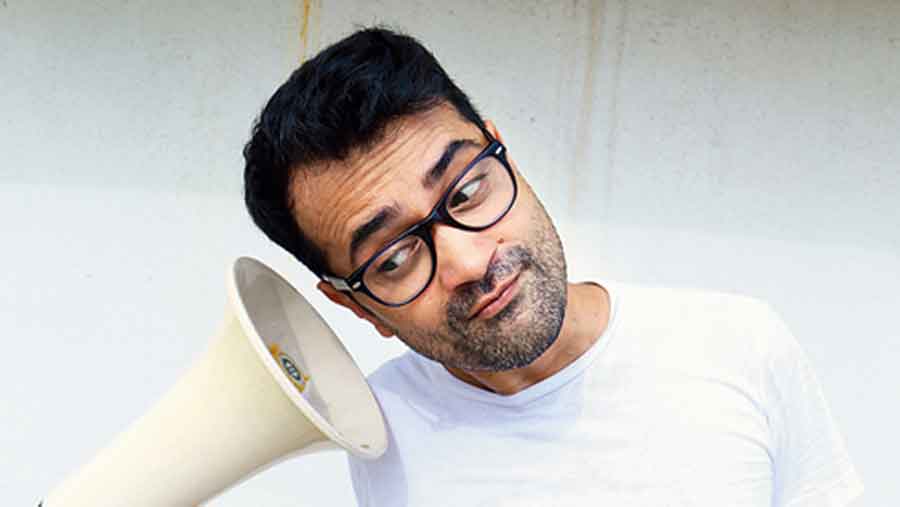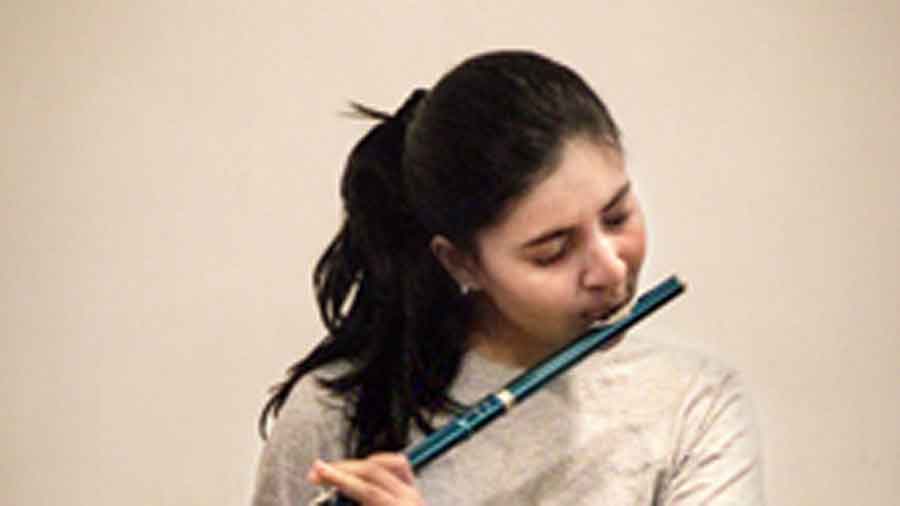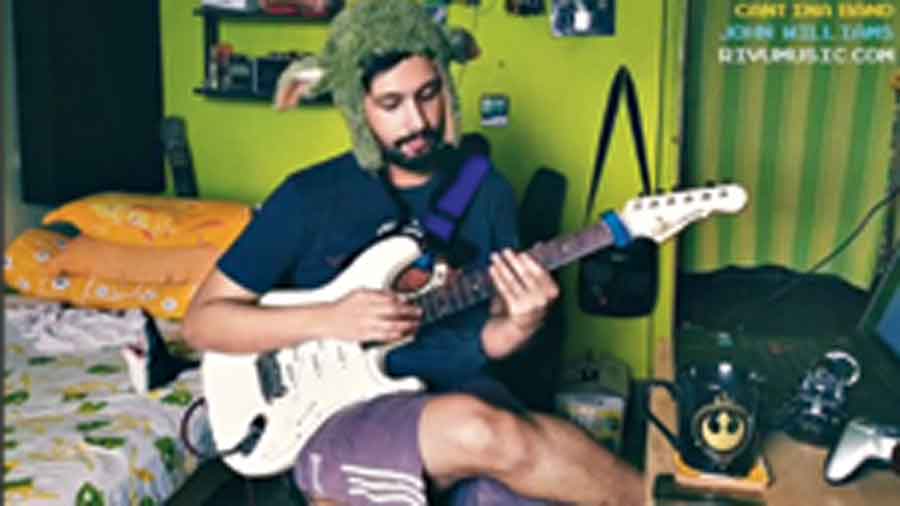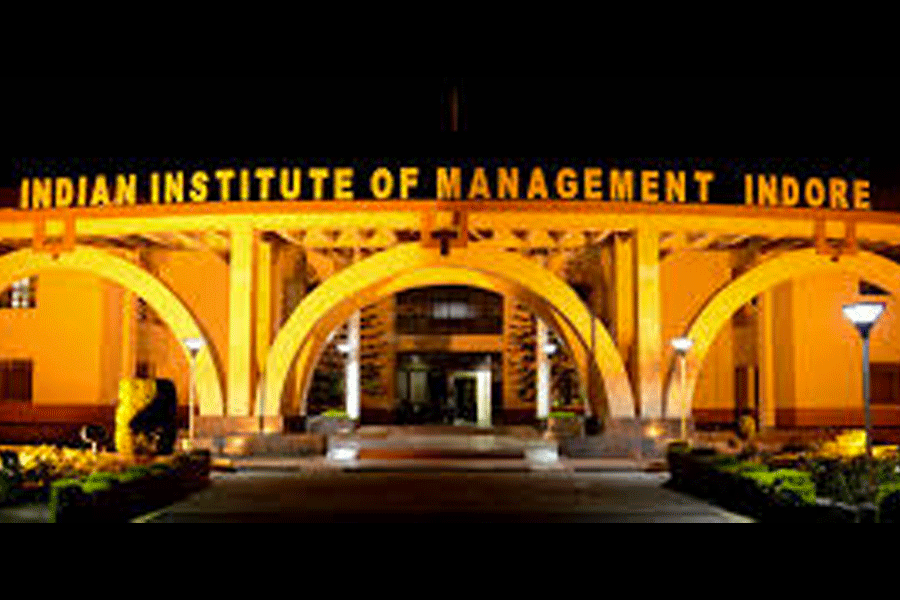Stumbling upon an Instagram story by percussionist Sambit Chatterjee about a story on the travelling struggles of a cricket team playing at the Indian Premier League this season, turned out to be the starting point for this article. Sambit’s caption reads: “I wish the struggles of indie artistes were highlighted in this manner.”
Each industry has its set of problems, so does the indie music scene, which is not all smiles and chords, especially during the pandemic. Each day new artistes try to launch themselves but how does one become an indie artiste? Is it enough to release a song that has been worked on at a studio?

Sambit Chatterjee (second from right) believes that an artiste should know their worth and not underquote just to get into the scene Picture courtesy: The artistes
Put it out online
For a newbie, when and where to start releasing music is important. The Internet is one’s best friend. New trap artiste from Calcutta, J. Rikh (Jeremy Rikh) makes it a point to upload a song every month. The 26-year-old has learned to produce, mix and master (starting in December 2019) tracks and he uploads and promotes his content using Spotify, Facebook ads and Instagram posts. “I make my own fliers and creatives, since I’m a full-time artiste. There aren’t any live shows and streaming revenue is not much, so you have to keep putting out content,” he says.
But for Shireen Ghosh (of Whale In The Pond), the “indie artiste” part of her life started when she shared her music with friends and college mates. Sourjyo Sinha (band member) was her senior in college and he would put out songs on Soundcloud. Soon, Shireen started playing music with him and later Deep Phoenix and Pilu (Sagnik Samaddar) joined in. “When it comes to creating content, putting it on the Internet is the most valuable resource. Even if it is not getting any attention, it is a good exercise,” she says. It is only after having a good body of work that you can show it to people for them to hire you for gigs and take you seriously. So just make music.
Will Neel Adhikari say that “these guys have it easier than we did”? With so many home studios available, it is easier for indie artistes to create content. “Back then”, the equipment required was unaffordable, booking a studio meant you had a time frame to meet and the clock kept ticking. Music also gets around faster these days because the channels of exposure and the number of channels of exposure.

People of my age will say, ‘I stopped listening to music in the ’90s.’... But many artistes have come and gone, so you can’t say good music has stopped — Neel Adhikari Picture courtesy: The artiste
Quality content
Music continues to evolve and every generation has something new to listen to. Good music will always be around. “People of my age will say, ‘I stopped listening to music in the ’90s.’ Or people from the previous generation will say good music stopped in the ’70s. But many artistes have come and gone, so you can’t say good music has stopped,” says Neel. Not only this, the new way of promoting one’s work is through visual media, which serves as a treat for the eyes and the ears. But music is supposed to be for the eardrums and presence of a visual representation may at times take away from what audio has to offer.
What bothers music producer and multi-instrumentalist Rivu is the way many indie artistes are promoted during a gig. He does not think that the promotion doesn’t offer people sufficient information. This has a lot to do with the lack of knowledge of some reviewers, promoters and PRs when it comes to indie music. “Their captions do not include any information about the artiste. It’s like ‘come for this jazz event’. People are intelligent but you have to treat them intelligently as well. Give them something interesting; do your research,” he said. Ironically Rivu was faced with a situation as well when someone told him that he finds indie artistes arrogant because they make music that at times they don’t understand and hence the audience doesn’t either. His response? “First of all, that is a wrong way of looking at artistes and secondly, then why art?”

Malini Banerjee is currently in Delhi, recording jingles Picture courtesy: The artiste
Support system
At a time when everyone is on the net, a lot of content seems to get lost in the kerfuffle. So what would it take for your content to standout? Buying and sharing your friend’s content of course but venues and organisers also need to team up and promote the work. There are times that indie artistes are paid according to the number of people they can bring to an event. “So what does the venue owner do? Just have a place?” asks Rivu.
The indie scene has always been self-sufficient but they’ve hardly got support from music labels unless it was for music festivals. Without the support, the indie scene also lacks the promotion on mainstream media, television and social media. Which works out well in a way because there is no compromise on quality and artistes don’t have to make music in a certain way. “But it could be great if Bollywood and films could incorporate some indie music in them,” says Adil Rashid of Underground Authority.
All the stress of working on music, coming up with content and working almost five other jobs can take a toll on one’s health. Sambit Chatterjee of Aswekeepsearching knows it well. The drummer of the band was diagnosed with scoliosis eight years ago and all the touring and carrying equipment took a toll on him. Last year, in July, he was scheduled to perform at two gigs, one with Rhythm Shaw and the other with Rhythm Shaw and his father, Nepal Shaw. The night before the concert Sambit had a neck spasm and his back and right arm were in pain. “My parents weren’t in Calcutta then, so Chitra (Chitrangada Satarupa) came to help me. I was hospitalised at 3am and my right arm’s blood circulation had stopped,” he said. After a few injections, Sambit was asked to rest for two days but he had to perform. Instead of taking rest he was on IV for six hours after which he performed at the two gigs and underwent physiotherapy later.

There’s no freedom and it’s a huge compromise signing with labels since they have control over everything — Adil Rashid Picture courtesy: The artistes
Pocket-friendly
Most of the indie artistes we spoke to made it clear that other than being an indie artiste they also have “other” jobs, some within the realm of music. Be it working on ads, playing in different bands, teaching music… an indie artiste needs a second job. “Either they’re playing in various bands or they’re being supported by their parents,” says Neel. He goes on to explain how he has built himself as an artiste from playing gigs at Someplace Else and staying as a paying guest, to moving to a flat with a traditional bathroom to what he is now. “Being an indie musician is about sacrifice and I have eaten the humble pie. I compromised on my standard of living and spread myself thinly.” While being an indie artiste Neel also taught himself production on the computer.
Even after a confirmed gig, indie artistes at times have a hard time getting what they’re owed. This is because a lot of the gigs are confirmed by word-of-mouth and at times payments are confirmed using an invoice. “Then again, no one really goes to the extent of suing for a small sum of money,” says Adil. Although there is great exposure with music festivals, there’s a lot of negotiations and indie artistes are expected to play at a lower price; pubs don’t pay much but it is the college fests that are ready to pay a huge sum of money.
Since the indie scene doesn’t come with a rule book, getting exploited is also very common. Shireen Ghosh was vocal about how some new places encourage new faces and indie music but are not willing to pay. “It’s understandable if they’re a start-up but you need to be honest about it.” There has also been a time when Shireen and her band were given a big sum of money in cash. “We don’t question where it’s coming from but it just seems shady,” she said.
But why do indie artistes settle for less? “Because small fish are taking bites out of small meals,” says Sambit. Artistes tend to underquote themselves just so they get more gigs because at the end of the day the audience is looking at the performer, not the amount of money they’re making. Is there a way to tackle this? Sambit believes that an artiste should know their worth and not underquote just to get into the scene. Because not only does this underpay artistes but destroys the level of competitors.

Shireen Ghosh of indie band Whale In The Pond Picture courtesy: The artiste
Labelled or nah?
With music labels being a huge promoter for artistes, many indie musicians prefer to be without their backing. Although it provides stability, it creates boundaries when it comes to the flow of an artiste. Signed artistes have deadlines to meet, which obstructs with the natural flow of composition. After all, music can’t be forced; it needs inspiration. Moreover, not many labels are willing to take big risks with indie musicians as the sound is new and how many people will buy their music is questionable. But signing with record labels gives one access to top studios and equipment.
Neel Adhikari says, “Sc*** that! Do you think a band like Whale in the Pond would like to record at a swanky studio? They will prefer recording in their bedroom.”
Music is just not about recording a track. There is an attachment to the vibe and setting of a place as well. There is a core thought and feeling involved when recording. Not signing with record labels also gives artistes time to do other things (like the five other jobs).
Some labels may even exploit an artiste, so keep an eye out for red flags. Calcutta-based band Underground Authority (UA) were faced with two mishaps when signing with record labels. According to Adil, it is a “strange” position to be in as some just want the rights to music, some push the artistes too much, turning the relationship sour. “There’s no freedom and it’s a huge compromise signing with them since they have control over everything,” he says. About ten years ago UA, with the help of a music label, flew down to Mumbai to record with some American producers. What was supposed to be their song was released under someone else’s name from which UA got no financial benefit. “We brought this matter up on Facebook but all they did was change the name of the song,” says Adil. But experiences like these have made UA steer clear from music labels unless it is a one-time deal for a song for digital distribution.

J. Rikh or Jeremy Rikh is a newly-launched artiste from Calcutta Picture courtesy: The artiste
Pandemic hit
The global pandemic has taken the stage away from all artistes and in times of uncertainty, it’s hard to stay motivated. Calcutta singer Malini Banerjee has travelled to Delhi and is working on a few jingles but she made sure to sanitise the entire studio! “How long can you sing for f***’s sake? Only last month some commercial work started coming in,” she says.
With many things being put on halt, most artistes are finishing their pending work but now with the festive season arriving, projects have started to come in. Although the last six months did have some releases, it is online shows that have kept musicians active. A Somlata and the Aces gig with Blooperhouse had sold about 700 tickets but even then there are some artistes who have had to cancel online gigs or have sold tickets till the last minute before the online concert to make it work. So how can the problem be solved? “There have to be more backers, investors, some weight behind the artistes. There is new music but it lacks funds,” she says. Although the government has unlocked many things, performing live seems to be a distant dream. Fifty people will buy tickets but only for well-known artistes.

Rivu in his elements during a fun video Picture courtesy: The artiste
A happy place
Even if the indie industry is faced with problems, it will always have original content (other than covers, of course). Each artiste will play his or her sound, express their emotions and if one overlaps the other, it is sheer coincidence that calls for a collaboration! Social media likes and post don’t define them but it is their unfiltered way of putting out messages that thrill us; it can range from politics to mental health to stories to extraterrestrial stuff. The indie music scene might not be “up there” but by diving into the field you can understand the humbleness, relate to it and build your playlist with sounds that are different.











